So here is the latest update!!
Thursday, November 29, 2007
Well, we are still here! But we have been very busy on site hence the lack of blog news. This year we have worked on some brilliant projects, most of which we are now writing up in the warm (ish) office.
So here is the latest update!!
So here is the latest update!!
Coffin Works
 Over the summer this year, from June to September, we have been engaged in an exciting project in the centre of Birmingham, at Newman Bros. Coffin Fitters. This work was undertaken on behalf of the Birmingham Conservation Trust, who intend to convert some of the works into a museum. The conversion will involve the reinstatement of all the fittings, furniture and other objects exactly as they were left on the day the works closed.
Over the summer this year, from June to September, we have been engaged in an exciting project in the centre of Birmingham, at Newman Bros. Coffin Fitters. This work was undertaken on behalf of the Birmingham Conservation Trust, who intend to convert some of the works into a museum. The conversion will involve the reinstatement of all the fittings, furniture and other objects exactly as they were left on the day the works closed.  Ironbridge Archaeology were employed to carry out the cataloguing, recording and removal of everything that was not nailed down (and some things that were!) prior to the renovation work being carried out. In this work the team were guided by Michael Worthington the project manager, who had carried out similar projects at the Jewellery Quarter and Broseley Pipe Works, and assisted by a team of volunteers. Things were made significantly more challenging due to the strict Health and Safety measures it was necessary to carry out. Numerous heavy metals were used in the manufacturing processes used on the site, and a significant amount of asbestos boarding was used in the building. For this reason it was necessary for the cataloguing team to wear protective gloves, P3 filter face masks and coveralls. In a fit of patriotism these last items were ordered in red, white and blue!
Ironbridge Archaeology were employed to carry out the cataloguing, recording and removal of everything that was not nailed down (and some things that were!) prior to the renovation work being carried out. In this work the team were guided by Michael Worthington the project manager, who had carried out similar projects at the Jewellery Quarter and Broseley Pipe Works, and assisted by a team of volunteers. Things were made significantly more challenging due to the strict Health and Safety measures it was necessary to carry out. Numerous heavy metals were used in the manufacturing processes used on the site, and a significant amount of asbestos boarding was used in the building. For this reason it was necessary for the cataloguing team to wear protective gloves, P3 filter face masks and coveralls. In a fit of patriotism these last items were ordered in red, white and blue!
The majority of the work required the cataloguing of boxes and boxes of coffin fittings such as breast plates, handles and coffin screws. However there were some more unusual finds such as the book of Masonic rituals, the funeral shroud in Aston Villa colours and a number of body-bags (presumably unused).
Wonderful Wednesbury
Since uncovering the first timber wheel race (Wheel Race 1) way back in March, and despite the very wet summer, we have found three more! Further excavation of Wheel Race 1 revealed the curved base of the wheel pit and friction marks on the side planks suggests the water wheel would have been around 4m in diameter. Fragments of the water wheel buckets were also discovered in the fill of the wheel pit.


Three additional wheel races were found to the south of Wheel Race 1, two of which sat directly beneath the later brick culverts. Wheel Race 2 was the longest surviving example consisting of two channels side by side. Like Wheel Race 1, this was constructed from oak, with a base frame, uprights and clay lined side boards. Mortice and tenon joints had been used to hold the structure together and some of the timbers bore the original carpenters marks in roman numerals.

We have since removed the timbers and they have been dated to the late 16th - 17th centuries and represent the earliest phase of the sites development. There have also been numerous small finds, including pottery, leather shoes, iron nails, a pewter spoon, gun barrels, many more gun flints, several coins, including a George II halfpenny, dated 1752 and a token dated 1788 – issued by John Wilkinson the Ironmaster.


Three additional wheel races were found to the south of Wheel Race 1, two of which sat directly beneath the later brick culverts. Wheel Race 2 was the longest surviving example consisting of two channels side by side. Like Wheel Race 1, this was constructed from oak, with a base frame, uprights and clay lined side boards. Mortice and tenon joints had been used to hold the structure together and some of the timbers bore the original carpenters marks in roman numerals.

We have since removed the timbers and they have been dated to the late 16th - 17th centuries and represent the earliest phase of the sites development. There have also been numerous small finds, including pottery, leather shoes, iron nails, a pewter spoon, gun barrels, many more gun flints, several coins, including a George II halfpenny, dated 1752 and a token dated 1788 – issued by John Wilkinson the Ironmaster.
Glenfield Railway Tunnel

September saw most of the team underground in Leicester, carrying out a photographic survey of the Glenfield Railway Tunnel prior to strengthening works.
The tunnel measures 1 mile and 36 yards long and originally formed part of the Leicester-Swannington Railway which was officially opened on July 13th 1832. It was the longest tunnel of its type in England when it was opened and formed part of the first locomotive railway in the East Midlands. The building of the railway was fuelled by the need to enable the collieries of the area to transport coal to the markets in Leicester though it was soon over taken by the Midland Railway Company and carried passengers until the 1920’s.
The archaeological work involved taking a full photographic record of the tunnels length, and recording in more detail areas that had undergone repairs or that revealed evidence of construction techniques.
Lapley Court

In the spring of this year we carried out a geophysical and EDM survey of the gardens surrounding a timber framed cruck building – Lapley Court - in the hope that additional bays of the cruck frame were surviving under the lawn. This appeared not to be the case, but the vaulted roof of a Victorian water tank was discovered and trial trenching exposed many pottery finds, including one sherd of Black Burnished Ware!
An additional box framed extension forms part of the site, which has received planning permission to be reinstated using traditional materials and techniques. We have been recording the framing prior to dismantling, as well as recording the original cruck framed structure.
Recording of the timber framing continues and has so far exposed some interesting details – including evidence of trestle sawing, whereby timbers were cut from the end, towards the middle, and then turned around on the trestle and worked from the other end. This created saw marks running at 45 degree angles and a triangular shaped ‘snap off’ point where the lines meet. This may date the cruck frame to the 16th century or possible even earlier.
Coalport Bridge

During a brief dry and warm period in August, we carried out a small excavation and watching brief at Coalport Bridge. This involved digging two small drainage trenches and it was anticipated that some early evidence of the bridges construction would be uncovered. The bridge was first constructed from timber, with stone abutments in 1780 and was then called the Preens Eddy Bridge though during a flood in 1795, the middle pier of the bridge was severely damaged and the design and construction was reconsidered altogether.
A second bridge was constructed c.1800-1818, being made of cast iron and timber and involved the redesign of the bridge to become just one arched span, (the original bridge having had two spans). Finally, in 1818, the bridge was completely replaced with cast iron and this design can still be seen today with addition of minor alterations and repairs.
Unfortunately, any evidence relating to the bridges construction was not discovered, although many finds associated with the nearby Woodbridge Inn were plentiful.
Thursday, March 08, 2007
Timber-framed wheelpit and tailrace
The final push of excavations at Wednesbury has revealed a timber-framed tailrace. This is similar in construction to excavated examples from medieval and later sites, with a timber base, into which are slotted timber uprights ('studs'). Planking is secured to the outer and inner faces of the studs to ensure a smooth flow of water within the wheelpit and tailrace.
 View of the wheel pit before excavation. The clay packing around the outside has been removed; pressure on the pit had caused it to collapse.
View of the wheel pit before excavation. The clay packing around the outside has been removed; pressure on the pit had caused it to collapse.
The wheelpit and tailrace probably date to the sixteenth century, although they may be earlier. Finds excavated so far suggest that it went out of use in the seventeenth century.
 These brick structures overlie another series of substantial timbers which form part of the sixteenth century forge.
These brick structures overlie another series of substantial timbers which form part of the sixteenth century forge.
Work will continue on the site until Easter.
 View of the wheel pit before excavation. The clay packing around the outside has been removed; pressure on the pit had caused it to collapse.
View of the wheel pit before excavation. The clay packing around the outside has been removed; pressure on the pit had caused it to collapse.The wheelpit and tailrace probably date to the sixteenth century, although they may be earlier. Finds excavated so far suggest that it went out of use in the seventeenth century.
 These brick structures overlie another series of substantial timbers which form part of the sixteenth century forge.
These brick structures overlie another series of substantial timbers which form part of the sixteenth century forge.Work will continue on the site until Easter.
Monday, February 12, 2007
Finds from Bridgnorth
Whilst the snow and rain have been driving down outside, post-excavation work for the Bridgnorth evaluation has been going on inside. Here is a selection of some of the finds...
 A rather gaudy selection showing the wide range of ceramics dumped in the river bylet.
A rather gaudy selection showing the wide range of ceramics dumped in the river bylet.
 Some lovely late 17th century slipware.
Some lovely late 17th century slipware.
 A selection of 19th century glass bottles, including Wollstein, Ironbridge (centre).
A selection of 19th century glass bottles, including Wollstein, Ironbridge (centre).
 Malthouse drying floor tiles, 19th century. The '4-hole' design to the rear is probably the earliest.
Malthouse drying floor tiles, 19th century. The '4-hole' design to the rear is probably the earliest.
 Maws 'sandwich' encaustic tile, dated to between 1860 and 1870 and made at their works in Benthall.
Maws 'sandwich' encaustic tile, dated to between 1860 and 1870 and made at their works in Benthall.
 The back of the tile - confirming the date range before the move to their Jackfield works in 1883.
The back of the tile - confirming the date range before the move to their Jackfield works in 1883.
Many thanks to Dr. Tony Herbert and Michael Vanns for information on the Maws Tile.
 A rather gaudy selection showing the wide range of ceramics dumped in the river bylet.
A rather gaudy selection showing the wide range of ceramics dumped in the river bylet. Some lovely late 17th century slipware.
Some lovely late 17th century slipware. A selection of 19th century glass bottles, including Wollstein, Ironbridge (centre).
A selection of 19th century glass bottles, including Wollstein, Ironbridge (centre). Malthouse drying floor tiles, 19th century. The '4-hole' design to the rear is probably the earliest.
Malthouse drying floor tiles, 19th century. The '4-hole' design to the rear is probably the earliest. Maws 'sandwich' encaustic tile, dated to between 1860 and 1870 and made at their works in Benthall.
Maws 'sandwich' encaustic tile, dated to between 1860 and 1870 and made at their works in Benthall. The back of the tile - confirming the date range before the move to their Jackfield works in 1883.
The back of the tile - confirming the date range before the move to their Jackfield works in 1883.Many thanks to Dr. Tony Herbert and Michael Vanns for information on the Maws Tile.
Friday, February 09, 2007
More snow
As promised, here are some more pictures of Coalbrookdale and Ironbridge in the snow. These photos were taken on Thursday...
 Dale House (left) and Rosehill House, built by the Darby family in the early 18th century, and overlooking the Upper Furnace Pool. The arch in the foreground is part of the railway viaduct of 1864.
Dale House (left) and Rosehill House, built by the Darby family in the early 18th century, and overlooking the Upper Furnace Pool. The arch in the foreground is part of the railway viaduct of 1864.
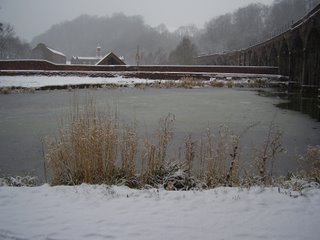 Unusual view across the Upper Furnace Pool, with the top of the furnace cover building peeping up above the dam wall.
Unusual view across the Upper Furnace Pool, with the top of the furnace cover building peeping up above the dam wall.
 View through the trees on towards the Great Warehouse (Museum of Iron).
View through the trees on towards the Great Warehouse (Museum of Iron).
 Established 298 years ago. The giant wheel is part of the Godalming Water Turbine.
Established 298 years ago. The giant wheel is part of the Godalming Water Turbine.
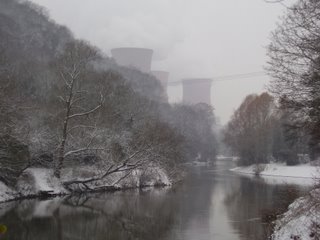 View upriver with the Ironbridge power station looming in the distance.
View upriver with the Ironbridge power station looming in the distance.
 The Iron Bridge, looking upstream from Severn Bank.
The Iron Bridge, looking upstream from Severn Bank.
 Cottages on the north bank of the River.
Cottages on the north bank of the River.
 Dale House (left) and Rosehill House, built by the Darby family in the early 18th century, and overlooking the Upper Furnace Pool. The arch in the foreground is part of the railway viaduct of 1864.
Dale House (left) and Rosehill House, built by the Darby family in the early 18th century, and overlooking the Upper Furnace Pool. The arch in the foreground is part of the railway viaduct of 1864. Unusual view across the Upper Furnace Pool, with the top of the furnace cover building peeping up above the dam wall.
Unusual view across the Upper Furnace Pool, with the top of the furnace cover building peeping up above the dam wall. View through the trees on towards the Great Warehouse (Museum of Iron).
View through the trees on towards the Great Warehouse (Museum of Iron). Established 298 years ago. The giant wheel is part of the Godalming Water Turbine.
Established 298 years ago. The giant wheel is part of the Godalming Water Turbine. View upriver with the Ironbridge power station looming in the distance.
View upriver with the Ironbridge power station looming in the distance. The Iron Bridge, looking upstream from Severn Bank.
The Iron Bridge, looking upstream from Severn Bank. Cottages on the north bank of the River.
Cottages on the north bank of the River.
Thursday, February 08, 2007
Snow
The widely-forecast snow has actually arrived. So here are some photographs of some of the Museum's buildings and monuments in the snow...
 View from the archaeology office window in the Long Warehouse. Outside is the 'Great Warehouse' of the Coalbrookdale Company, now the Museum of Iron. The warehouse was built in 1838 and the clock tower was added in 1843.
View from the archaeology office window in the Long Warehouse. Outside is the 'Great Warehouse' of the Coalbrookdale Company, now the Museum of Iron. The warehouse was built in 1838 and the clock tower was added in 1843.
 The Upper Forge was in use from the 16th and 17th centuries. These surviving buildings are 18th century.
The Upper Forge was in use from the 16th and 17th centuries. These surviving buildings are 18th century.
 The recently-restored overflow sluices from the former Upper Forge Pool.
The recently-restored overflow sluices from the former Upper Forge Pool.
 Rose Cottage, near the site of the former Middle Forge. The cottages were built in the 1640s.
Rose Cottage, near the site of the former Middle Forge. The cottages were built in the 1640s.
It is still snowing now (late morning), so more photos will be taken this afternoon and will no doubt appear here in due course.
 View from the archaeology office window in the Long Warehouse. Outside is the 'Great Warehouse' of the Coalbrookdale Company, now the Museum of Iron. The warehouse was built in 1838 and the clock tower was added in 1843.
View from the archaeology office window in the Long Warehouse. Outside is the 'Great Warehouse' of the Coalbrookdale Company, now the Museum of Iron. The warehouse was built in 1838 and the clock tower was added in 1843. The Upper Forge was in use from the 16th and 17th centuries. These surviving buildings are 18th century.
The Upper Forge was in use from the 16th and 17th centuries. These surviving buildings are 18th century. The recently-restored overflow sluices from the former Upper Forge Pool.
The recently-restored overflow sluices from the former Upper Forge Pool. Rose Cottage, near the site of the former Middle Forge. The cottages were built in the 1640s.
Rose Cottage, near the site of the former Middle Forge. The cottages were built in the 1640s.It is still snowing now (late morning), so more photos will be taken this afternoon and will no doubt appear here in due course.
Wednesday, February 07, 2007
Darby Furnace Beam
In 1972 the outer lamination of one of the beams to the Darby Furnace was in a poor state of repair and was 'rescued'. It was taken to the then Ancient Monuments Laboratory (AML) of the Department of the Environment (Ministry of Works). The former AML is now the English Heritage Centre for Archaeology, and is situated at Fort Cumberland in Portsmouth.
During a recent clear-out the box containing the beam fragments was discovered. This week Paul went down to collect the remains and repatriate them! Due to their fragile nature a full photographic record was made of all of the bits.
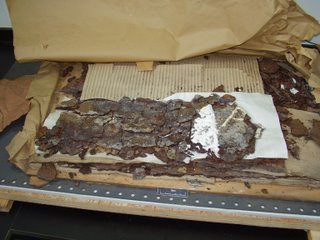 Not a promising start - rather tired packaging full of rust!
Not a promising start - rather tired packaging full of rust!
 ...and more rust!
...and more rust!
 Rather fragmented slice of metal, but is that an 'A' at the end?
Rather fragmented slice of metal, but is that an 'A' at the end?
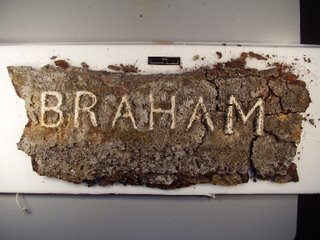 and then we have a '...BRAHAM'
and then we have a '...BRAHAM'
 and finally a 'DARBY 1777' came out of the box!
and finally a 'DARBY 1777' came out of the box!
The fragments were carefully repacked before being driven 'home' to Ironbridge...
 Slightly more modern materials used, and carefully wedged together!
Slightly more modern materials used, and carefully wedged together!
Many thanks to Justine Bayley, Vanessa Fell and the staff at the Centre for Archaeology in Portsmouth.
During a recent clear-out the box containing the beam fragments was discovered. This week Paul went down to collect the remains and repatriate them! Due to their fragile nature a full photographic record was made of all of the bits.
 Not a promising start - rather tired packaging full of rust!
Not a promising start - rather tired packaging full of rust! ...and more rust!
...and more rust! Rather fragmented slice of metal, but is that an 'A' at the end?
Rather fragmented slice of metal, but is that an 'A' at the end? and then we have a '...BRAHAM'
and then we have a '...BRAHAM' and finally a 'DARBY 1777' came out of the box!
and finally a 'DARBY 1777' came out of the box!The fragments were carefully repacked before being driven 'home' to Ironbridge...
 Slightly more modern materials used, and carefully wedged together!
Slightly more modern materials used, and carefully wedged together!Many thanks to Justine Bayley, Vanessa Fell and the staff at the Centre for Archaeology in Portsmouth.
Wednesday, January 31, 2007
Excavations at Bridgnorth
After the problems with flooding a couple of weeks ago the river levels have now dropped and so we have been able to get on with work. The main aim of the trench has been to try and find the line of a former bylet. We were successful in locating the eastern edge of this feature, which was marked by a revetment wall.
 Keith recording the trench section. He is standing on the line of the former bylet, with the revetment wall in the foreground.
Keith recording the trench section. He is standing on the line of the former bylet, with the revetment wall in the foreground.
The wall itself is made of sandstone blocks, which are ashlared on the western (river front) side. However the wall has also been given a front facing of brickwork which protects the relatively soft stone from erosion. The brick facing is quite late, but we have recovered an earlier brick from the core of the wall.
 Detail of the wall const- ruction, from the river side.
Detail of the wall const- ruction, from the river side.
We have found a wide range of artefacts, including nineteenth century bottles and drying floor tiles from the period when the site was in use as a malthouse. We have also recovered a number of earlier pieces, including seventeenth century slipware and tin-glazed earthenware. Photos of the finds will be posted once cleaning and cataloguing is completed.
 Keith recording the trench section. He is standing on the line of the former bylet, with the revetment wall in the foreground.
Keith recording the trench section. He is standing on the line of the former bylet, with the revetment wall in the foreground. The wall itself is made of sandstone blocks, which are ashlared on the western (river front) side. However the wall has also been given a front facing of brickwork which protects the relatively soft stone from erosion. The brick facing is quite late, but we have recovered an earlier brick from the core of the wall.
 Detail of the wall const- ruction, from the river side.
Detail of the wall const- ruction, from the river side.We have found a wide range of artefacts, including nineteenth century bottles and drying floor tiles from the period when the site was in use as a malthouse. We have also recovered a number of earlier pieces, including seventeenth century slipware and tin-glazed earthenware. Photos of the finds will be posted once cleaning and cataloguing is completed.
Monday, January 29, 2007
The End
Sad scenes on site at Wednesbury Forge as the final stage of demolition of the upstanding structures is nearing completion. These are mainly twentieth century buildings, but still containing memories of high-quality English manufacturing industry. Having come to know the site well over the last five years, it is heart-breaking to see the once fastidiously clean managers' offices being pulled apart and thrown on the bonfire by demolition workers.
 Plant room to the tool shop, during demolition.
Plant room to the tool shop, during demolition.
 Posters advertising quality on the wall of the former conference room.
Posters advertising quality on the wall of the former conference room.
 Foundation stone laid by Edward Elwell, saved from the crusher.
Foundation stone laid by Edward Elwell, saved from the crusher.
 Plant room to the tool shop, during demolition.
Plant room to the tool shop, during demolition. Posters advertising quality on the wall of the former conference room.
Posters advertising quality on the wall of the former conference room. Foundation stone laid by Edward Elwell, saved from the crusher.
Foundation stone laid by Edward Elwell, saved from the crusher.
Monday, January 15, 2007
Flooding at Bridgnorth
Work has started today on our evaluation in Bridgnorth. The main objective is to locate a 'bylet' - a small subsidiary channel of the River Severn. This may have medieval origins, and was certainly present for most of the post-medieval period. However recent rain has resulted in high water levels which have made progress somewhat difficult. Last week the floodwaters were very high so we postponed opening the trench until this week.
 The site backs onto the river, and water levels were still rising when this photo was taken last week...
The site backs onto the river, and water levels were still rising when this photo was taken last week...
However despite a couple of dry days the water has been slow to recede. Part of the problem is that the relict reiver channel we are looking for will of course hold water for much longer than the surrounding landscape.
 Water seeping up through the trench. So far we have only removed rubble layers tipped in the 1960s.
Water seeping up through the trench. So far we have only removed rubble layers tipped in the 1960s.
We have decided to postpone the work for another week in the hope that the river levels fall further. At present there is no point pumping out the excavation as it would re-flood very quickly.
 The site backs onto the river, and water levels were still rising when this photo was taken last week...
The site backs onto the river, and water levels were still rising when this photo was taken last week...However despite a couple of dry days the water has been slow to recede. Part of the problem is that the relict reiver channel we are looking for will of course hold water for much longer than the surrounding landscape.
 Water seeping up through the trench. So far we have only removed rubble layers tipped in the 1960s.
Water seeping up through the trench. So far we have only removed rubble layers tipped in the 1960s.We have decided to postpone the work for another week in the hope that the river levels fall further. At present there is no point pumping out the excavation as it would re-flood very quickly.
Friday, January 12, 2007
Happy New Year
Well 2007 has already kicked off to an exciting start with projects up and coming from all directions. This includes new building recording and excavation projects in the west midlands region and further afield, plus more work in the Ironbridge Gorge, the continuation of excavations at Wednesbury - and further research projects in Coalbrookdale. In addition we will be launching our new monograph series, featuring a series of important metallurgical and ceramic production sites.
 Malthouse tiles recovered from excavations in Coalbrook- dale.
Malthouse tiles recovered from excavations in Coalbrook- dale.
Watch this space for further updates!
 Malthouse tiles recovered from excavations in Coalbrook- dale.
Malthouse tiles recovered from excavations in Coalbrook- dale.Watch this space for further updates!
Wednesday, December 20, 2006
MERRY CHRISTMAS
A very Merry Christmas to everyone, and best wishes for 2007!
 Snow falling over the Darby Furnace, as a coal train passes on the viaduct.
Snow falling over the Darby Furnace, as a coal train passes on the viaduct.
Some more photos of Coalbrookdale in the snow can be found in an earlier post. This one is a bit of a cheat, as it was taken in March 2006 so it does not represent current weather conditions! Although it has been very foggy lately, and this morning (20th December) it was in fact minus one and frosty, snow looks pretty unlikely this year!
 Snow falling over the Darby Furnace, as a coal train passes on the viaduct.
Snow falling over the Darby Furnace, as a coal train passes on the viaduct.Some more photos of Coalbrookdale in the snow can be found in an earlier post. This one is a bit of a cheat, as it was taken in March 2006 so it does not represent current weather conditions! Although it has been very foggy lately, and this morning (20th December) it was in fact minus one and frosty, snow looks pretty unlikely this year!
Monday, December 11, 2006
New buildings at Jackfield
Part of the development of the Jackfield Tile Museum has involved the demolition of late twentieth century foundry buildings and their replacement with early twenty-first century 'arts' buildings. Part of this new structure overlies the old kiln which we discovered in September last year (see earlier post on the subject).
 Looking through the entrance archway the new building looms into sight. Deliberately 'new' in contrast to the existing structures, and echoing the footprint and roofline of the buildings it replaces.
Looking through the entrance archway the new building looms into sight. Deliberately 'new' in contrast to the existing structures, and echoing the footprint and roofline of the buildings it replaces.
The new building contains arts and crafts workshops let out to various tenants, and the upper floor will contain a gallery.
 Looking through the entrance archway the new building looms into sight. Deliberately 'new' in contrast to the existing structures, and echoing the footprint and roofline of the buildings it replaces.
Looking through the entrance archway the new building looms into sight. Deliberately 'new' in contrast to the existing structures, and echoing the footprint and roofline of the buildings it replaces.The new building contains arts and crafts workshops let out to various tenants, and the upper floor will contain a gallery.
Wednesday, November 29, 2006
Ditherington Flax Mill
Further recording at Ditherington Flax Mill has been ongoing on behalf of English Heritage. Structural repair to the main mill is being accompanied by ongoing archaeological recording. This has enabled us to have a good look at many of the later features associated with the conversion of the building to a maltings in the nineteenth century.
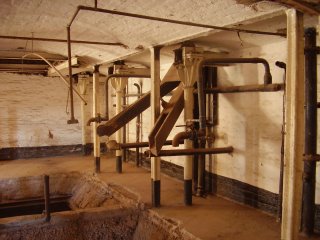 Hoppers and chutes for moving grain around the maltings.
Hoppers and chutes for moving grain around the maltings.
 Hoppers and chutes for moving grain around the maltings.
Hoppers and chutes for moving grain around the maltings.
Thursday, November 23, 2006
Finds from Wednesbury Forge
The 2006 phase of excavation work at Wednesbury Forge has now finished. Further work will take place on site next year once the remaining buildings on site have been demolished. The team are now hard at work back in the office processing the finds from the project. Here is a selection of some of the material which we have recovered...
 Eighteenth century gunflints.
Eighteenth century gunflints.
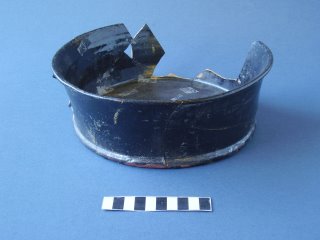 Eighteenth century earthen- ware.
Eighteenth century earthen- ware.
 Local nineteenth century bottles
Local nineteenth century bottles
 Nineteenth century scissors.
Nineteenth century scissors.
 Twentieth century bowling ball (marked 'EAC' - Elwell's Athletic Club)
Twentieth century bowling ball (marked 'EAC' - Elwell's Athletic Club)
For more information about the site please scroll down for earlier posts.
 Eighteenth century gunflints.
Eighteenth century gunflints. Eighteenth century earthen- ware.
Eighteenth century earthen- ware. Local nineteenth century bottles
Local nineteenth century bottles Nineteenth century scissors.
Nineteenth century scissors. Twentieth century bowling ball (marked 'EAC' - Elwell's Athletic Club)
Twentieth century bowling ball (marked 'EAC' - Elwell's Athletic Club)For more information about the site please scroll down for earlier posts.